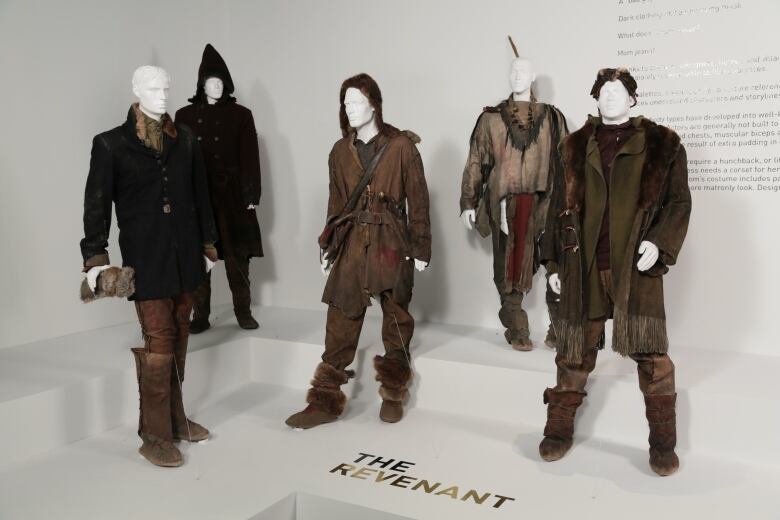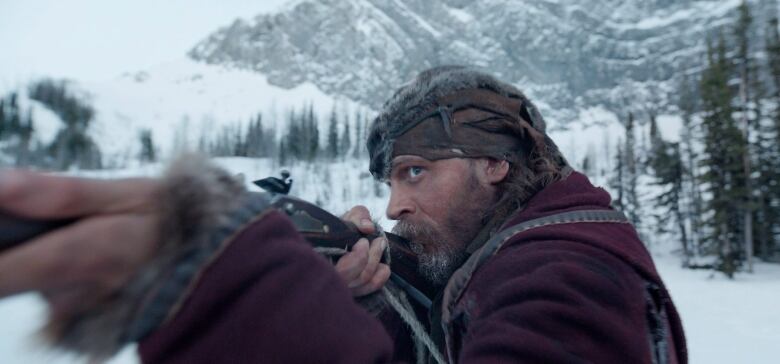The Revenant costumes designed to weather 'extreme' Canadian climate
Designer Jacqueline West says biggest challenge was 'just to keep people from dying in the wilderness'

How do you make clothes so ragged that they look like they were mauled by a bear, yet warm enough to prevent your star from freezing to death?
That was just one of the challenges faced by Oscar-nominated costume designer Jacqueline West during her time in Canada filming The Revenant.
- The Revenant triumphs at BAFTA awards
- The Revenant tests heart-pounding action with wearable technology
- Ant shortage, prosthetic buffalo among challenges for animal trainer on The Revenant
"Nature is definitely a character in this film, you feel it every step of the way," West said at a Los Angelesexhibit dedicated to Oscar-nominated costumes at theFashion Institute of Design & Merchandising. "The clothes had to tell a story."
The Revenant is the story of Hugh Glass (played by Leonardo DiCaprio), a mountain man who survives a bear attack only to be left for dead by his companions, set in the early 1800s.
It was mostly filmed in Alberta, which she calls "one of the most beautiful landscapes in the world." But it was also one of the most challenging.

DiCaprio's character was plunged in icy water and stranded in sub-zero temperatures, so West had to make the clothes look realistic but also large enough to accommodate warm clothing underneath, like dry suits and gear mountain climbers wear "just to keep people from dying in the wilderness," West says.
"One day we were shooting and it was 40 below when we quit shooting that night. So weather conditions were extreme."
Her toolkit ran from high-tech clothing lined with electric wiring to keep the actors warm to low-tech: a greasy mixture of wax, oil and lamp black to emulate the bear grease aboriginal people and trappers used to waterproof and insulate clothing.
"It created this patina that emulated exactly what bear grease looked like when we rubbed animal fats on these skins," West says.
The Revenant's director Alejandro G. Irritu liked the look so much that he insisted the woman who applied the black wax Karen Durrant be beside him at all times.
"We even gave her the name 'Walks With Black Wax' because she applied so much of it on the clothes," West says.

In order to create realistic-looking period clothing, West spent months researching the look of the era's frontiersmen. All the clothing was hand-stitched and hand-sewn.
"It had to be historically accurate, in that there weren't sewing machines out there in the wilderness, so everything was hand-done," West says. "Even the blankets were hand-blanket-stitched."
One of the most important things to get right, she says, was the look of the First Nations people depicted in the film. She wanted to go beyond the "cookie-cutter" image of Plains Indians.
"Not using fringe or beads or any of the things we've seen in the clich rendition of the American tribes, but to make them individual and use artwork that they would have used on their elk-skin blankets," West says. "I had to be diligent and resourceful maintaining the looks of the different tribes."
As for the costume that has become a symbol for the movie DiCaprio's bear-skin costume it was designed after West studied bear attacks to see how they would rip and shred clothing.

Throughout the movie, the costume changed to represent the character's own evolution.
"It was the thing that almost killed him, and poetically, it's the thing that saved his life," West says.
She got the bear hide itself from a Canadian parks department.
"So it would be a bear that died of natural causes," West says. "Working in Canada was wonderful for that reason. They're so sustainable and they care about the environment so passionately, Canadians. And they're so into preservation. The whole country is an animal conservatory, so it was a perfect place to work on a project like this."
West is nominated for an Academy Award for costume design for her work on The Revenant. The film netted a total of 12 Oscar nods.














_(720p).jpg)


 OFFICIAL HD MUSIC VIDEO.jpg)
.jpg)



























































































